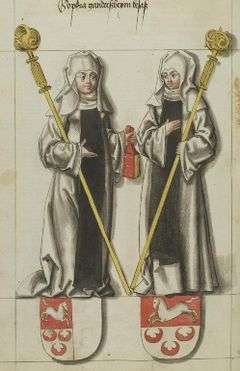Sophia I, Abbess of Gandersheim
Sophia I (September 975[1] – 30 January 1039), a member of the royal Ottonian dynasty, was Abbess of Gandersheim from 1002, and from 1011 also Abbess of Essen. The daughter of Emperor Otto II and his consort Theophanu, she was an important kingmaker in medieval Germany.[2]
| Sophia I | |
|---|---|
 Adelaide of Quedlinburg and Sophia of Gandersheim, by Lucas Cranach (1546) | |
| Abbess of Gandersheim | |
| Reign | 1002–1039 |
| Predecessor | Gerberga II |
| Successor | Adelaide II |
| Abbess of Essen | |
| Reign | 1011–1039 |
| Predecessor | Mathilde |
| Successor | Theophanu |
| Born | September 975(?) |
| Died | 30 January 1039 Gandersheim Abbey, Saxony |
| Burial | |
| Dynasty | Ottonian |
| Father | Otto II, Holy Roman Emperor |
| Mother | Empress Theophanu |
| Religion | Roman Catholic |
Early life
According to the chronicles by Thietmar of Merseburg, Sophia was born to Emperor Otto II and Theophanu. She may have been the first surviving daughter, born in 975, though other sources indicate that her sister Adelaide, born 977, was in fact the eldest. Sophia is first documented in a 979 deed of donation, when her father entrusted her education to his first cousin, Abbess Gerberga II of Gandersheim. Sophia was raised and educated in Gandersheim Abbey to become abbess from childhood.[3] Abbess Gerberga taught her convent discipline and common law, both of which she mastered.[4] Sophia received many grants of rights and property from her father as well as from her brother, Otto III, who succeeded as King of the Romans in 983.
Sophia took the vows to become a canoness in 989. As an emperor's daughter, she insisted on receiving the veil from the hands of Archbishop Willigis of Mainz, the archchancellor of the Holy Roman Empire, affronting the local Bishop Osdag of Hildesheim. The contemporary chronicler Thangmar, in his Vita Bernwardi (Life of Saint Bernward), reveals a fierce row between the church leaders in front of King Otto III, his mother Theophanu and the royal court. She was finally consecrated by both. In Hildesheim sources, Sophia is portrayed as a haughty and imperious woman, though these depictions may be biased.
Sophia and her brother seemed to be on good terms with each other; she received several gifts and attended the 994 Imperial Diet, where Otto was declared to have reached majority. He vested his sister with the estates of Eschwege Abbey, at the explicit wish of their late mother Theophanu who had died in 991. From 995 until 997, Sophia was absent from the convent, accompanying her brother on his first Italian campaign and acting as his consort. She acted as abbess of Eschwege from 997. Thereafter, however, she no longer appeared at Otto's court.
Princess-abbess
In 1001, her tutor Abbess Gerberga II of Gandersheim died. However, due to her brother's death, Sophia was not to be elected her successor until 1002, with the approval of the new king Henry II. Sophia would later fight her ecclesiastical superiors who, with approval of Emperor Henry II, endangered Gandersheim's privileges and her own status.[3][4]
Together with her sister Adelaide of Quedlinburg, Sophia significantly influenced the election of Henry II as King of the Romans and legitimized him in 1024, when he visited Vreden and Quedlinburg. Sophia and her sister later played the same role in the election of Conrad II as first Holy Roman Emperor of the Salian dynasty.[3]
In 1011, Sophia was also granted Essen Abbey on the death of her cousin Mathilde. The succession had initially been reserved for her younger sister Matilda, who nevertheless had married Count Palatine Ezzo of Lotharingia instead. According to the local historian Georg Humann (1847–1932), Essen was always secondary for Sophia, and the importance of the abbey declined somewhat under her rule. The rebuilding of Essen Minster was delayed, though recent research suggests that it was Sophia who initiated the remodelling of the Enamel Cross.
Death
She ruled her abbeys successfully until her death in 1039. Despite the help he had received from the sisters, Conrad II denied Adelheid's request to succeed Sophia as Abbess of Gandersheim. Henry III, Holy Roman Emperor, eventually granted her the right to rule Gandersheim too.[2][3]
Ancestry
| Ancestors of Sophia I, Abbess of Gandersheim | |||||||||||||||||||||||||||||||||||||||||||||||||||||||||||||||||||||||||||||||||||||||||||||||||||||||||||||||||||||||||||||||||||||||||||||||||||||||||||||||||||||||||||||||||||||||||||||||||||||||||||||||||||||||||||||||||||||||||||||||||||||||||||||||||||||||||||||||||||||||||||||||||||||||||||||||||||||||||||||||||||||||||||||||||||||||||||||||||||||||||||||||||||||||||||||||||||||||||||||||||||||||||||||||||||||||||||||||||||||||||||||||||||||||||||||||||||||||||||||||||||||||||||||||||||||||||||||||||||||||||||||||||||||||||||||
|---|---|---|---|---|---|---|---|---|---|---|---|---|---|---|---|---|---|---|---|---|---|---|---|---|---|---|---|---|---|---|---|---|---|---|---|---|---|---|---|---|---|---|---|---|---|---|---|---|---|---|---|---|---|---|---|---|---|---|---|---|---|---|---|---|---|---|---|---|---|---|---|---|---|---|---|---|---|---|---|---|---|---|---|---|---|---|---|---|---|---|---|---|---|---|---|---|---|---|---|---|---|---|---|---|---|---|---|---|---|---|---|---|---|---|---|---|---|---|---|---|---|---|---|---|---|---|---|---|---|---|---|---|---|---|---|---|---|---|---|---|---|---|---|---|---|---|---|---|---|---|---|---|---|---|---|---|---|---|---|---|---|---|---|---|---|---|---|---|---|---|---|---|---|---|---|---|---|---|---|---|---|---|---|---|---|---|---|---|---|---|---|---|---|---|---|---|---|---|---|---|---|---|---|---|---|---|---|---|---|---|---|---|---|---|---|---|---|---|---|---|---|---|---|---|---|---|---|---|---|---|---|---|---|---|---|---|---|---|---|---|---|---|---|---|---|---|---|---|---|---|---|---|---|---|---|---|---|---|---|---|---|---|---|---|---|---|---|---|---|---|---|---|---|---|---|---|---|---|---|---|---|---|---|---|---|---|---|---|---|---|---|---|---|---|---|---|---|---|---|---|---|---|---|---|---|---|---|---|---|---|---|---|---|---|---|---|---|---|---|---|---|---|---|---|---|---|---|---|---|---|---|---|---|---|---|---|---|---|---|---|---|---|---|---|---|---|---|---|---|---|---|---|---|---|---|---|---|---|---|---|---|---|---|---|---|---|---|---|---|---|---|---|---|---|---|---|---|---|---|---|---|---|---|---|---|---|---|---|---|---|---|---|---|---|---|---|---|---|---|---|---|---|---|---|---|---|---|---|---|---|---|---|---|---|---|---|---|---|---|---|---|---|---|---|---|---|---|---|---|---|---|---|---|---|---|---|---|---|---|---|---|---|---|---|---|---|---|---|---|---|---|---|---|---|---|---|---|---|---|---|---|---|---|---|---|---|---|---|---|---|---|---|---|---|---|---|---|---|---|---|---|---|---|---|---|---|---|---|---|---|---|---|---|---|---|---|---|---|---|---|---|---|---|---|---|---|---|---|---|---|---|---|---|---|---|---|---|---|---|---|---|---|---|---|---|---|---|---|---|---|---|---|---|---|---|---|---|---|---|---|---|
| |||||||||||||||||||||||||||||||||||||||||||||||||||||||||||||||||||||||||||||||||||||||||||||||||||||||||||||||||||||||||||||||||||||||||||||||||||||||||||||||||||||||||||||||||||||||||||||||||||||||||||||||||||||||||||||||||||||||||||||||||||||||||||||||||||||||||||||||||||||||||||||||||||||||||||||||||||||||||||||||||||||||||||||||||||||||||||||||||||||||||||||||||||||||||||||||||||||||||||||||||||||||||||||||||||||||||||||||||||||||||||||||||||||||||||||||||||||||||||||||||||||||||||||||||||||||||||||||||||||||||||||||||||||||||||||
References
- Seibert, Hubertus (1998). Otto II. Neue Deutsche Biographie (NDB) Volume 19 (in German). Historische Kommission, Bayerische Akademie der Wissenschaften (BAdW). pp. 660–662.
- Wolfram; Kaiser, Herwig; Denise Adele (2006). Conrad II, 990-1039: emperor of three kingdoms. Penn State Press. ISBN 0-271-02738-X. Retrieved 2009-07-09.
- Bernhardt, John W. (2002). Itinerant Kingship and Royal Monasteries in Early Medieval Germany, C.936-1075. Cambridge University Press. ISBN 0-521-52183-1. Retrieved 2009-07-08.
- Eckenstein, Lina (1894). Women under Monasticism. Cambridge University Press. Retrieved 2009-07-11.
Sophia I, Abbess of Gandersheim Born: 975 Died: 30 January 983 | ||
| Religious titles | ||
|---|---|---|
| Preceded by Gerberga II |
Abbess of Gandersheim 1002–1039 |
Succeeded by Adelaide II |
| Preceded by Mathilde |
Abbess of Essen 1011–1039 |
Succeeded by Theophanu |